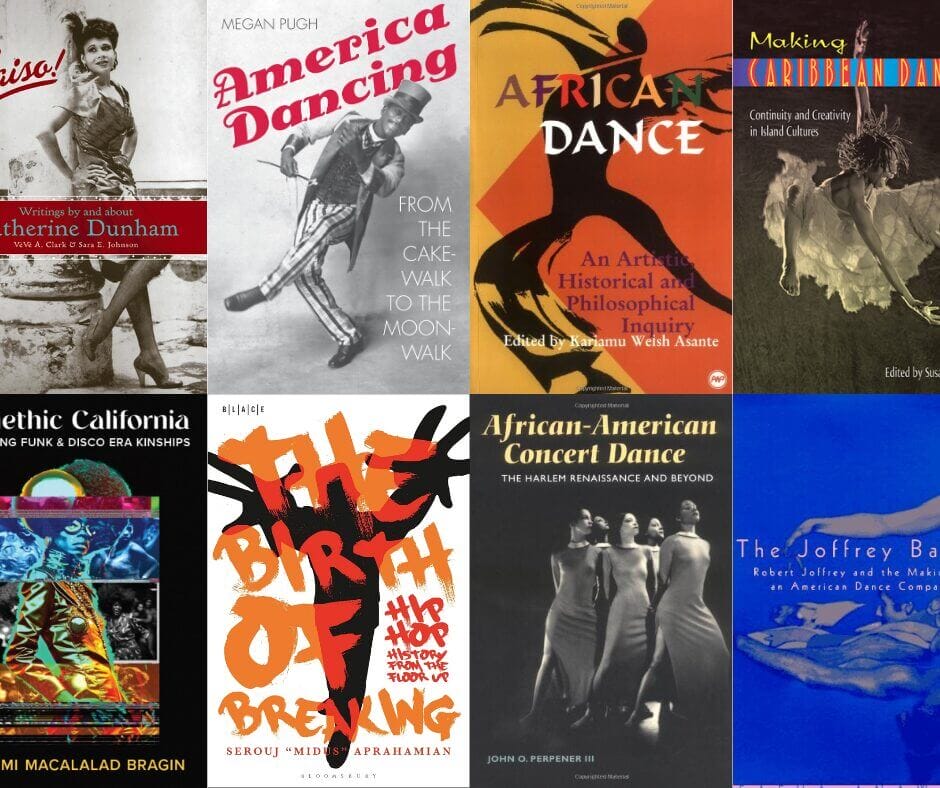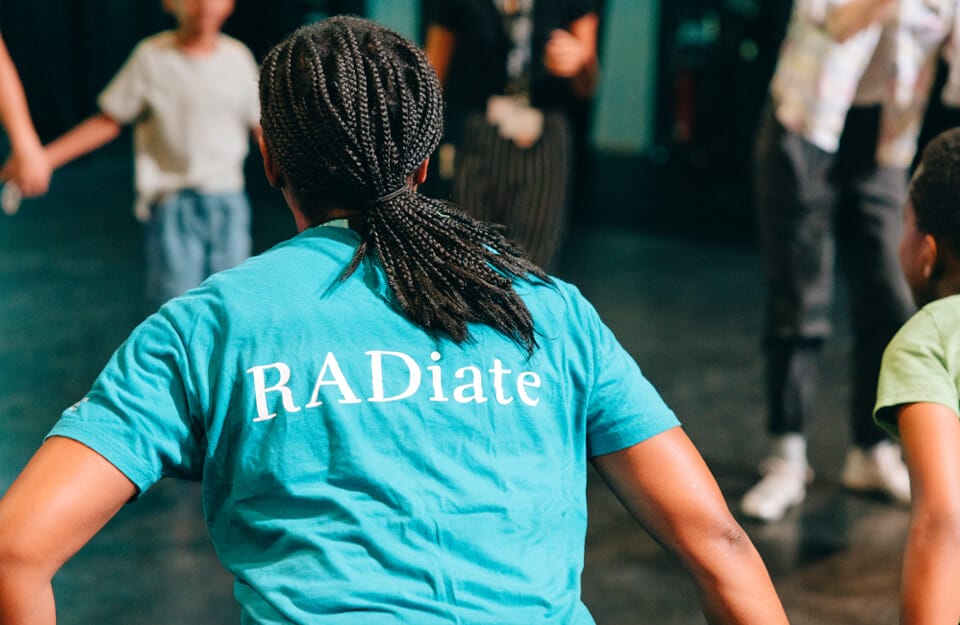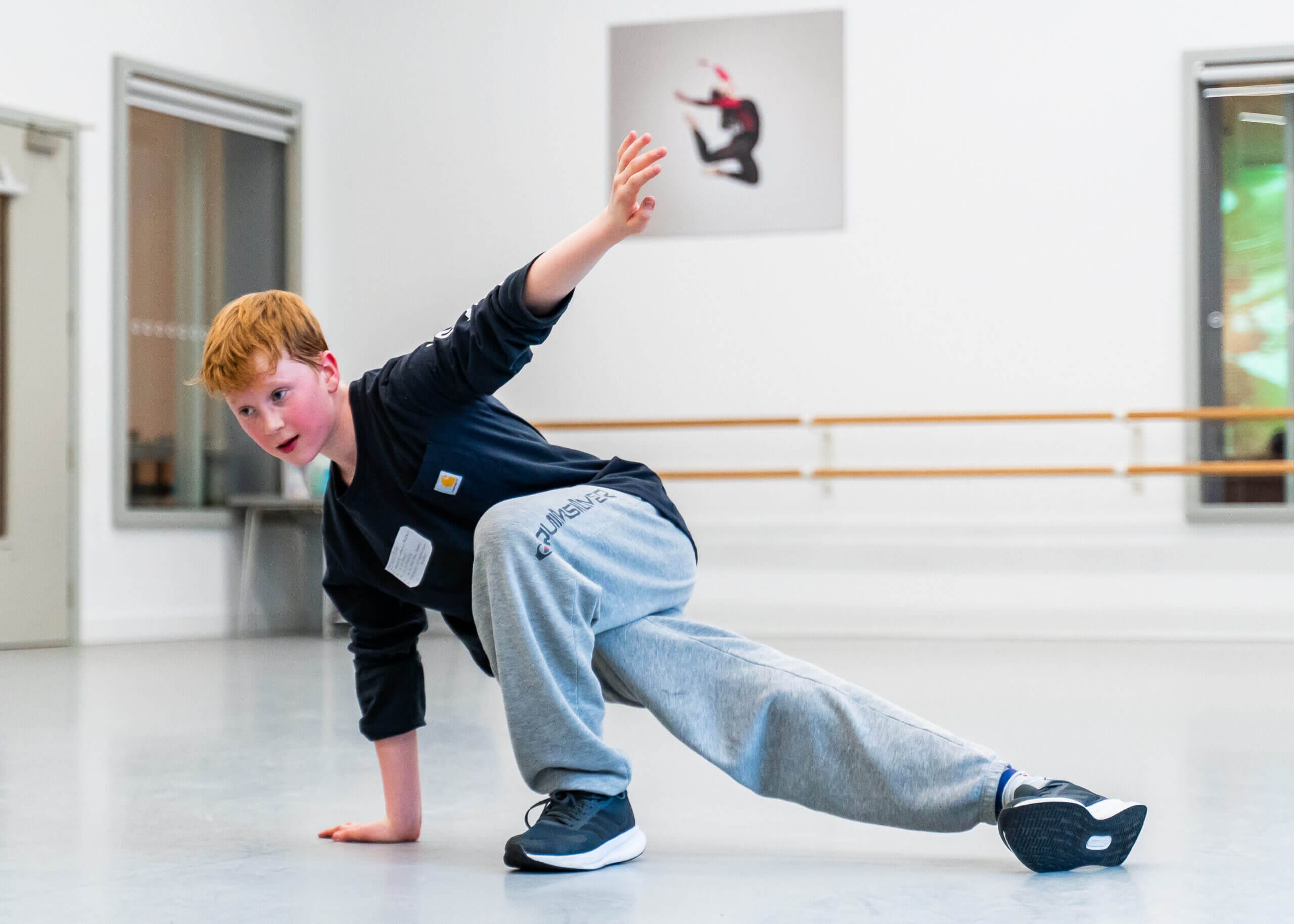Black History Month 2025: Standing Firm in Power and Pride

Dance in West and Central Africa has always been about more than movement—it is spirit, story, and community. Rooted in rhythm, percussion, and the shared energy of the circle, it carried people through rituals, celebrations, and daily life.
When millions of Africans were violently uprooted and trafficked to the Americas and the Caribbean during the transatlantic slave trade, they faced relentless efforts to erase their cultures. Yet they carried their movement traditions as acts of power and pride. Dance became a language of resistance, resilience, and remembrance, from the ring shout and juba, to samba, rumba, cumbia, and capoeira, generating new dance forms and greater freedoms within dance as social and artistic expression. Read more below to learn about the history of Black dance this Black History Month.
The events highlighted in the timeline have been selected based on resources available in the library. The links on the timeline lead directly to those resources for further reading.
A timeline of Black dance
1830s – Early 1880s: Minstrel Shows, Cakewalk & Vaudeville
In a time of extreme racism and exclusion, dance becomes a way for Black communities to express themselves, challenge stereotypes, and create new styles that blend tradition with innovation.
- 1830s: In the US, Minstrel shows emerge as racist entertainments built on blackface and caricature. Yet Black artists use these restrictive spaces to assert artistry, humour, and subtle forms of resistance. William Henry ‘Master Juba’ Lane becomes the first widely celebrated Black professional dancer in the U.S. His fast, percussive jigs lay the foundations of tap dance. Juba!: A Novel
- 1830s: In Trinidad and other Caribbean islands, enslaved Africans and their descendants blended rhythms and movement with indigenous footwork and European social dance steps, creating hybrid dances like calinda and rumba. Making Caribbean Dance: Continuity and Creativity in Island Cultures
- 1840s – 1850s: Originating among enslaved people on southern plantations as a satirical mimicry of white dances, the cakewalk goes on to become the first Black-created dance to gain popularity in white society in the 1870s–1880s. It influences later social and theatrical dances, while white communities remained oblivious to the dance’s subversive origins. America Dancing: From the cakewalk to the moonwalk
- 1865: Jook houses emerged after emancipation as informal social and cultural centres for African Americans in the rural South. Gaining prominence during the Jim Crow and Prohibition eras, they provided vital spaces for music, dancing, and community life, serving as cultural sanctuaries. Jookin’: The Rise of Social Dance Formations in African-American Culture
- 1880s: Vaudeville variety shows create new opportunities for Black performers. Tap, song, and comedy flourish on these stages, with stars such as Bert Williams, the Hyers Sisters, and the Whitman Sisters achieving national fame. Voices for Freedom: The Hyers Sisters’ Dream, Change, and Legacy
1900s – 1930s: Jazz, Charleston, Lindy Hop, Tap
Black arts and culture flourish under the Harlem Renaissance. Social dances such as the Lindy Hop, Charleston, and Black Bottom became popular.
- 1916: Bill ‘Bojangles’ Robinson performs his first solo tap act, developing a light, upright tap style distinct from minstrel traditions. Mr Bojangles; Black Tap Dance and its Women Pioneers
- 1919: Post–World War I migration brings thousands of Black Americans to Harlem and other northern cities, fuelling dance clubs and cabarets where jazz and tap evolve. African American Concert Dance: The Harlem Renaissance and Beyond
- 1925: Josephine Baker dazzles at her Paris debut; blending Africanist aesthetics with jazz-age glamour, her ‘banana skirt’ dance becomes legendary, and her rendition of the Charleston ignited an international dance craze. Baker uses her international fame to protest racial segregation and discrimination in the United States and refuses to perform for segregated audiences. Historia Josephine Baker
- 1928: At Harlem’s Savoy Ballroom, the Lindy Hop emerges, blending jazz, Charleston, and African American vernacular movement. It becomes a defining social dance of the Swing era, spreading Black dance innovation nationally and internationally through clubs, competitions, and later film. Frankie Manning: Ambassador of Lindy Hop
- 1930s: The Whitman Sisters were at the height of their fame, touring extensively, performing sophisticated tap and jazz routines, mentoring younger performers and shaping Black dance culture nationally. The Royalty of Negro Vaudeville: The Whitman Sisters and the negotiation of race, gender and class in African American theater, 1900-1940
- 1933: Prominent Black ballroom dance duo Norton and Margot (Harold Norton and Margot Webb) perform together for the first time. Their elegant routines, including waltz, tango, and bolero, gain recognition in entertainment circuits internationally. Waltzing in the Dark: African American Vaudeville and Race Politics in the Swing Era
1940s: Jazz, Tap, Stage Dance & Carnival
Black dancers and companies expand into Broadway and Hollywood, bringing tap and jazz to the UK while Caribbean influences reshape UK dance culture post-Windrush.
- 1943: Pearl Primus makes her professional debut, using dance as a medium for political and social consciousness, not just entertainment. She combines anthropological research and cultural realism to present African and African American dance authentically, and choreographed works that directly addressed racism, lynching, colonial oppression, and civil rights. The Dance Claimed Me: A Biography of Pearl Primus
- 1945: Katherine Dunham opens the Katherine Dunham School of Dance & Theatre in New York, training Black dancers and pioneering the integration of African and Caribbean dance traditions into modern concert dance. Kaiso! Writings By and about Katherine Dunham
- 1946: Les Ballets Nègres is founded in London by Jamaican dancers Berto Pasuka and Richie Riley. It is the first Black dance company in Europe, drawing on Caribbean and African diasporic traditions, its legacy inspires future generations. British Dance: Black Routes
- 1948: Arrival of the Empire Windrush brings a new wave of Caribbean culture to the UK, influencing carnival celebrations and urban dance culture. Caribbean and Atlantic Diaspora Dance: Igniting Citizenship
1950s: Ballet
Amid ongoing segregation in the US and prejudice in the UK, Black dancers begin to challenge classical norms, pushing for inclusion and redefining ballet aesthetics.
- 1955: Raven Wilkinson joins Ballet Russe de Monte Carlo, becoming one of the first African American women to perform full-time in a major US classical ballet company. Whilst Wilkinson could legally dance in a private company, segregation laws still shaped where she could stay, eat, and socialise. Trailblazer: The story of ballerina Raven Wilkinson
- 1955: Arthur Mitchell joins New York City Ballet (NYCB) in 1955, becoming the first African American principal dancer at a major US ballet company. Mitchell worked closely with George Balanchine, performing iconic roles & breaking racial barriers in classical ballet. Arthur Mitchell coaching the Pas de Deux from Agon
- 1956: The Joffrey Ballet is founded. From its inception, the company emphasises inclusive casting and diverse repertoire, providing opportunities for Black dancers and choreographers at a time when many major ballet companies are less accessible. The Joffrey Ballet: Robert Joffrey and the Making of an American Dance Company
- 1958: Alvin Ailey founded Alvin Ailey American Dance Theater, to bring African American cultural expression to concert dance. Storytelling, community, and social themes are emphasised through modern dance. Revelations (1963) becomes iconic.
Revelations: The Autobiography of Alvin Ailey
1960s: Contemporary Dance
Dance becomes a vehicle for activism, identity, and empowerment, reflecting the spirit of the civil rights and Black Power movement.
- 1966: The first Notting Hill Carnival takes place, celebrating Caribbean culture and dance in London. Voicing Black Dance: The British Experience 1930s-1990s
- 1967: Lester Horton’s Techniques gain wider influence, merging classical, Native American, and African diasporic movement vocabularies. He plays a crucial role in training and supporting Black dancers when they are excluded from most mainstream dance institutions. Lester Horton Technique: Intermediate Level
- 1969: Sammy Davis Jr. becomes a Broadway and Hollywood star and brings tap to mainstream entertainment in films like Sweet Charity.
- 1969: Arthur Mitchell founded Dance Theatre of Harlem after the assassination of Martin Luther King Jr., creating a space for Black dancers in classical and contemporary ballet and fostering new generations of artists. Dance Theatre Of Harlem: A History, a Movement, a Celebration
1970s: New Social Dance Movements
Black and Latinx communities in the U.S. created new street dance forms rooted in funk, soul, and African diasporic movement. In the UK, Afro-Caribbean influences shaped urban dance and carnival expression, while barriers in classical ballet persisted even as Black dancers pushed for change and visibility.
- 1970: In New York, Los Angeles, and Chicago, funk and soul music drive new social dances like the Mashed Potato, the Twist, and the Robot. These improvisational styles emphasise improvisation and body isolations and lay the groundwork for Hip Hop’s emergence later in the decade. Kinethic California: Dancing Funk and Disco Era Kinships
- 1975: Julie Felix, who trained at Rambert, performs in Sleeping Beauty with London Festival Ballet but is denied a permanent contract due to her skin colour. Moves to the U.S. in 1977 to join Dance Theatre of Harlem, performs internationally, returns mid-80s to teach, coach, and helps expand ballet access for Black dancers in the UK. Brickbats & Tutus: The Amazing Story of Julie Felix, Britain’s First Black Ballerina
- Late 1970s: Hip-hop culture grows from Bronx block parties into a global movement, blending music, dance, and visual art. In the UK, Afro-Caribbean carnival and street styles shape new forms of urban expression. The Birth of Breaking: Hip Hop History from the Floor Up | Freshest Kids: A history of the b-boy
1980 – 1990s: Street & Club
Street and club dance styles reflect social unrest, cultural pride, and the emergence of alternative spaces for expression, especially among marginalised youth.
- 1981: Riots in Brixton and other UK cities highlighted racial and social inequalities, sparking young Black and Caribbean communities to express themselves through dance and music.
- 1981: Phoenix Dance Theatre is founded in Leeds by Black British dancers, gaining recognition for its dynamic contemporary dance and community-focused performances. Dancing the Black Question: The Phoenix Dance Company Phenomenon
- 1982: Bentley’s nightclub opens in Canning Town, London. Reggae, Dancehall, & Ska; Jamaican music and dance styles are revolutionising British nightlife and Caribbean music culture is firmly embedded in clubs and youth scenes. Dancehall in/securities: Perspectives on Caribbean Expressive Life
- 1989: The ‘Paris Is Burning’ ballroom competitions are held in New York City, bringing together Black and Latinx LGBTQ+ communities in Harlem. Voguing emerges as a performative, competitive dance emphasising dramatic poses, angular movements, and improvisation. Voguing and the House Ballroom Scene of New York, 1989-92
- 1989: After Alvin Ailey’s death, Judith Jamison becomes Artistic Director of Alvin Ailey American Dance Theatre. Jamison ensures the company stays true to African American modern dance traditions and gives opportunities to emerging Black choreographers. Dancing Spirit: The Legacy and Vision of Judith Jamison
- 1990: Carlos Acosta becomes the first Black dancer to win the Prix de Lausanne gold medal, marking the start of his global career. Tocororo: A Cuban Tale
- 1991: Adzido Pan-African Dance Ensemble (founded in 1984) is the first documented Black dance organisation to receive regular Arts Council funding. The Oak tree bears fruit: The Achievement of Adzido Pan African Dance Ensemble: An education pack in support of the Company’s production of Coming Home
- 1996: The Association of Dance of the African Diaspora (ADAD) is established. One Dance UK – Dance of the African Diaspora in the UK and the legacy of ADAD
2000 – 2015: Urban Dance
New companies, films, and artists bring hip-hop, ballet, and contemporary styles to mainstream stages, while archives and institutions begin formally preserving and celebrating Black dance heritage.
- 2001: Boy Blue Entertainment is founded in the UK, bringing Hip Hop and contemporary Black dance to theatrical stages. Emancipation of Expressionism
- 2001: Ballet Black is founded in London by Cassa Pancho to support dancers of Black and Asian descent. Ballet Black: The Waiting Game
- 2004: The release of the film You Got Served brings Hip Hop and street dance into the spotlight of mainstream cinema, showcasing crew battles and choreography rooted in Black urban culture, and inspiring a wave of dance films and global interest. Blurring Boundaries: Urban Street Meets Contemporary Dance
- 2011: First Position documentary features Michaela DePrince, an orphan from Sierra Leone. Trained in the US, DePrince becomes a soloist with Dutch National Ballet (2013) and later Boston Ballet (2021).
- 2013 – 2016: Black Dance Archive is launched to preserve the legacy of UK Black British dance from the 1950s to the present through archival materials and community engagement.
- 2015: Misty Copeland Becomes ABT’s first African American female principal dancer, breaking historic barriers in classical ballet and inspiring future generations of Black dancers worldwide. Life in Motion: An Unlikely Ballerina
- 2015: South African-born dancer Oti Mabuse, eight-time South African Latin American Champion, joins Strictly Come Dancing as the first Black professional dancer on the show, later achieving consecutive wins in 2019 & 2020. Dance With Oti: The Bird Jive
2020 – 2025: Global Fusion & Digital Era
Digital platforms amplify Black dance globally, sparking conversations about cultural ownership, while fusion styles reflect evolving identities and transnational connections.
- 2020: COVID-19 lockdowns and Black Lives Matter protests boost Black dance on TikTok, Instagram, and YouTube, popularising Afrobeat, voguing, and other diaspora styles. This surge sparks debates on cultural appropriation, respect, and credit for Black creators. Milestones in Dance in the USA
- 2020: The shift toward digital and online media leads to popular dance being published digitally, creating fewer traditional published resources, impacting how information about Black dance history is recorded and accessed.
- 2022: Maxfield Haynes becomes the first genderfluid soloist at the Metropolitan Opera House, using innovative pointe work to challenge gender norms and create visibility and opportunities for the queer Black community in classical ballet. Black Queer Dance: Gay men and the Politics of Passing for Almost Straight
- 2024: Michaele DePrince dies, at age 29. Through her advocacy and memoirs, Taking Flight and Hope in a Ballet Shoe, she had become a powerful voice for resilience and diversity in ballet. Her death is a sad loss to the dance world. Taking Flight: From War Orphan to Star Ballerina
- 2024 – 25: Exhibition Into the Light: Pioneers of Black British Ballet tours the UK and highlights the contributions of Black dancers in UK ballet from the 1940s to the present, using archival materials, interviews, and media documenting their legacy.
- 2025: Library of Congress Black Dance Research Guide is released. This guide expands access to archival resources and celebrates the cultural impact of Black dancers and choreographers.




